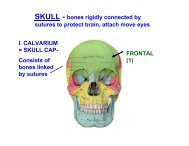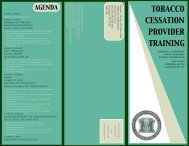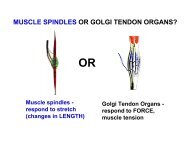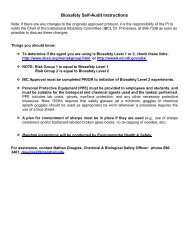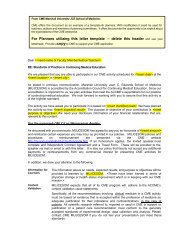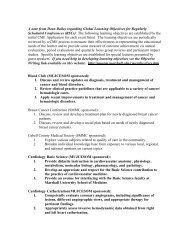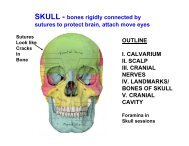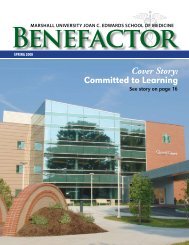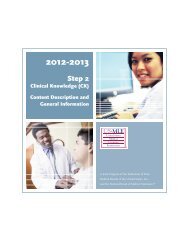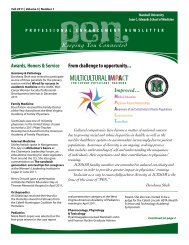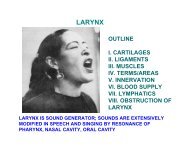FA 5 Progress Report WV-INBRE - Joan C. Edwards School of ...
FA 5 Progress Report WV-INBRE - Joan C. Edwards School of ...
FA 5 Progress Report WV-INBRE - Joan C. Edwards School of ...
- No tags were found...
Create successful ePaper yourself
Turn your PDF publications into a flip-book with our unique Google optimized e-Paper software.
Program Director/Principal Investigator (Last, First, Middle): Rankin, Gary O 117discussed genomics and next generation sequencing. Dr. Santanam gave an oral presentation entitled“Epicardial fat biomarkers in patients with coronary artery disease: <strong>WV</strong>-Appalachian Heart Study”. (5) Dr.Rankin also prepared a presentation entitled “Update on NIH EPSCOR-Like Programs” for the WestVirginia Science and Research Council meeting on January 26, 2012.AC and HSTA: The AC is continuing to develop the links between <strong>WV</strong>-<strong>INBRE</strong> and the <strong>WV</strong>U HealthSciences and Technology Academy (HSTA) program headed by PI, Dr. Ann Chester. The<strong>WV</strong>-<strong>INBRE</strong>/HSTA Coordinator, Valerie Watson (<strong>WV</strong>U) has established interactive connections with theHSTA regional clubs throughout the state and representatives <strong>of</strong> the <strong>WV</strong>-<strong>INBRE</strong> partner institutions. Ms.Watson coordinated talks by <strong>INBRE</strong> undergraduate research interns and high school science educatorresearch interns at some HSTA club meetings. Informational brochures were sent to HSTA Field SiteCoordinators in 18 West Virginia counties. In addition, a <strong>WV</strong>-<strong>INBRE</strong>-HSTA Task Force has been formed toexplore ways to enhance the <strong>WV</strong>-<strong>INBRE</strong> and HSTA interactions. <strong>WV</strong>-<strong>INBRE</strong> also utilized one <strong>of</strong> its foursupplements (3P20RR016477-09S3) to enhance <strong>WV</strong>-<strong>INBRE</strong> HSTA activities. Funds from this supplementwere used to place eight undergraduates in <strong>WV</strong>-<strong>INBRE</strong> funded research labs at the five partner institutionsduring the academic year <strong>of</strong> 2010-2011 and two students have been placed in two laboratories in2011-2012 to date. Seven <strong>WV</strong> high school science educators were placed in biomedical research labs atMarshall University, Shepherd University, University <strong>of</strong> Charleston, and West Virginia State University toconduct summer research projects in 2011.Bioinformatics Core (BC)BC members provided assistance with experimental design, statistical analysis and use <strong>of</strong> IngenuityPathways Analysis (IPA) tools in the interpretation <strong>of</strong> results have resulted in 6 publications in peer reviewedjournals, with an additional paper in press, and 16 presentations at national or regional meetings. BCresources have supported 18 grants, including 7 funded NIH grants, 2 pending NIH grants, a grant pendingfor DARPA, 2 grants funded by local sources, and 5 grants that were not funded (NIH, NSF, IARPA and aprivate foundation). In partnership with the COBRE-funded <strong>WV</strong>U Center for Neuroscience Genomics Coreand the <strong>WV</strong> Clinical Translational Science Institute, the <strong>WV</strong>-<strong>INBRE</strong> has established and equipped acomputational facility to support analyses <strong>of</strong> large or complex datasets using bioinformatic or statisticalapproaches. The facility also functions as a classroom lab, and is in use for teaching <strong>of</strong> bioinformatics tograduate students. <strong>WV</strong>U is in the process <strong>of</strong> hiring a new bioinformaticist/biostatistician. This position is beingfunded by COBREs at <strong>WV</strong>U (Neuroscience and Cancer), <strong>WV</strong>-<strong>INBRE</strong>, and the emerging <strong>School</strong> <strong>of</strong> PublicHealth. The pool <strong>of</strong> candidates includes many individuals with experience analyzing high dimensional datafrom expression or NexGen datasets, and using various algorithms for developing new methods forextracting meaningful relationships from these datasets. The BC is currently using Partek forNextGeneration Sequence analysis. Dr. Denvir is additionally using CASAVA to analyze data generated bythe Illumina HiSeq 1000 at MU, and MACS to analyze Chip-seq data. The BC is currently initiating amonth-long trial <strong>of</strong> CLC Genomics Server and Workbench with a view to purchase and install before thebeginning <strong>of</strong> the next budget year. We anticipate this s<strong>of</strong>tware will enable the BC to centralize access toand analysis <strong>of</strong> Next Generation Sequencing data.Participation in Program <strong>of</strong> Excellence: Dr. James Denvir, Bioinformatics Core Co-Director, is participating asa potential mentor for the Southeast <strong>INBRE</strong> Region Program <strong>of</strong> Distinction Bioinformatics Internships forUndergraduate Student. If the project is selected by undergraduate student(s), Dr. Denvir, collaborating witha faculty researcher, will mentor the student intern in bioinformatics analysis <strong>of</strong> biological data.Genomics Core (GC)The GC continues to support the research <strong>of</strong> investigators within the <strong>WV</strong>-<strong>INBRE</strong> network. The GC providedthe following services in Y11: (1) next generation sequencing (NGS), (2) microarray-based gene expressionpr<strong>of</strong>iling and pathway analysis, (3) automated DNA sequencing and access to DNA/RNA sequenceanalysis s<strong>of</strong>tware, (4) access to real-time PCR instrumentation, NanoDrop spectrophotometers and AgilentBioAnalyzer for DNA/RNA analysis and (5) access to the Luminex 100 for multiplex protein detection. Dr.PHS 2590 (Rev. 06/09)Continuation Format Page



